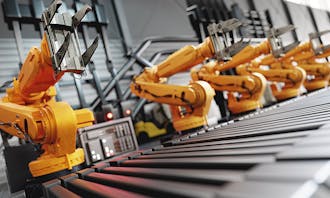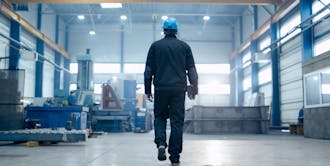- Home >
- Interviews >
-
John Young
John Young - EU Automation
2023-08-29
5 min read

Q. There is an expected global industrial automation market growth of an astonishing 265 billion dollars by 2025. There’s no doubt that the adoption of automation across multiple sectors has driven the huge growth in recent years. These include developments in Industry 4.0 technology and the Industrial Internet of Things, or I.I.O.T.
Thank you for having me. I’m looking forward to discussing the fundamentals of modern manufacturing.
Q. Let's dive right in. Can you give us a snapshot of the current landscape of automation in manufacturing?
Absolutely. Today, we see an advanced adoption of automation across manufacturing. From AI-based systems, collaborative robots to machine vision.
There's a broad spectrum of technologies that are transforming the industry. However, the process of automation adoption needs to be systematic to truly reap the benefits.
Without a clear roadmap for implementation, manufacturers run the risk of under utilizing their new technology. In some cases they may even risk making their existing processes more complex. Or, in extreme examples, bringing production to a halt altogether.
These issues are easily avoidable though, as long as you have a proper plan!
Q. That strikes me as both fascinating and a little bit unsettling. What does it mean to adopt a systematic approach in automation?
That is an excellent point to bring up! And, truth be told, you have no reason to be concerned about it. The examples I gave are easily avoidable.
In short, systematic adoption of automation involves a structured process. It starts with preparation, where companies need to understand their needs and identify suitable automation technologies.
Next is implementation, where these technologies are integrated into the manufacturing process. Then comes operation, where the technologies are put to use and monitored regularly. Finally, regular maintenance ensures long-term operational efficiency.
The processes themselves shouldn’t be new concepts to any experienced professional. If the time is taken to undergo these exercises then the benefits of automation are really massive.
Q. It seems pretty straightforward when you put it like that. However, I’m sure for a large facility it’s anything but a simple process. What are the common challenges that companies face during this journey?
The size of the operation and the scope of the application will definitely have an impact. The challenges do vary. But, typically, the common challenges that businesses come across tend to share similarities.
Unfortunately, I can’t offer you a one size fits all solution, or explanation right here. There are simply too many variables involved. However, we can certainly dissect a few of the most typical challenges that factories confront when they adopt automation.
Q. There appears to be a considerable quantity to cover. Should we jump right in?
Yeah, of course. I’d say that one of the main pitfalls that manufacturers need to avoid when trying to implement this type of technology is simply underestimating the complexity of the job itself.
In most cases, it requires numerous parties, each with their own set of technical knowledge and expertise. You need robust decision-making and excellent communication to meet your objectives.
Implementing an automation system without first thoroughly planning your approach can be a very risky and potentially expensive mistake.
Q. Are there any specific risks that our listeners should be particularly aware of?
Certainly. As I mentioned earlier, each application will come with it’s own set of variables to consider. But, one essential question to ask yourself is whether the product you’re considering implementing is definitely suitable for the application.
This might sound silly, but there are lots of examples of industry-leading companies, such as Boeing and Tesla, that have stripped out entire automation lines and reverted back to manpower for certain processes. This is because their automation applications simply weren’t fit for purpose.
”
Implementing an automation system without first thoroughly planning your approach can be a very risky and potentially expensive mistake.
”
Q. Removing complete automation assemblies seems like an extreme measure for such large corporations as Boeing and Tesla to adopt. The cost involved in this must be astonishing!
Well, I think we can definitely assume that the price they paid for those miscalculations will have definitely stung! The fact that these companies aren’t immune from these issues just goes to highlight how important it is to ensure all due diligence and testing has been carried out well in advance of any actual implementation.
If you work in the automotive business or a similar industry, it is imperative that you review your proposed robotics projects. Consider them not just once, but twice or even three times before proceeding.
It’s not just Boeing and Tesla that have fallen foul of these issues. Both Mercedes and Toyota have also stripped out automation production in favour of other production methods. It is more prevalent than you may believe.
Q. So far, you have provided us with much to contemplate! Are there any other roadblocks to be aware of before we start to implement automation in our production lines?
We still need to mention one of the more troublesome complications in the process… That’s us. Or, should I say, the human workforce. It’s in our nature to resist change. And, transforming a production facility with machines is a pretty big change to adapt to.
It’s important to say that I don’t mean to imply that every professional in the manufacturing industry is inherently against robotics. Far from it. However, resistance is certainly something to prepare for if you’re planning a considerable automation project.
Unfortunately, there are a lot of unfounded claims that robots are making humans redundant. As we’ve already discussed, this clearly is not the case. The likes of Boeing, Tesla, Mercedes, and Toyota are doing away with automation in favour of a human workforce. Therefore, there does not appear to be much support for an argument that we are all obsolete.
There will always be a need for humans in the workplace, even if a facility completely automates its production line. It's possible that robots are the best option for carrying out those boring, repetitive jobs that we'd rather not undertake. But that just means there are more opportunities for upskilling, career progression and better job satisfaction for their human colleagues.
Q. It's reassuring to know that all of us still have value! So, now that we know what hurdles to watch out for, what steps can be taken to ensure that projects are a success?
When you have confidence in your project's viability and support from key stakeholders, you're well on your way to success.
One final, vital practice to make sure you’ve considered is maintenance. Automated systems and robotics offer an immense operational advantage. However, the functionality of the machines heavily relies on the condition of their individual parts.
It is your responsibility to maintain the system once it is running.
Preventative maintenance and timely replacements can mitigate most unforeseen system failures and avoid costly downtime. Malfunctioning components may signal an impending system breakdown, so monitoring and immediate action can save both time and resources.
Implementing a rigorous predictive maintenance strategy will make sure that your newly adopted automation system keeps working hard for you.
Q. John, today's conversation has covered a wide range of subjects. Should the points you’ve expanded on today give our listeners a good starting point if they’re about to embark on their own automation project?
They should certainly serve as a jumping off point. If you can tick the boxes we’ve highlighted today then you’re definitely on your way to a successful project.
Q. You mentioned earlier that this isn’t by any means an exhaustive list of every single challenge or best practice. If our listeners wanted to find out more about automation adoption, where would you recommend that they look?
I’d definitely recommend visiting euautomation.com and checking out our Knowledge Hub. It contains movies, articles, reports, and a great deal of other content as well.
We’ve also got a dedicated Robotics report. We will publish this soon and cover the topics we’ve spoken about today in much more detail. Be sure to check that out.
Q. Fantastic. This has been quite eye-opening and educational, John. Thank you for shedding light on such an important topic and giving us some actionable advice.
I am pleased that we had the opportunity to have this discussion. Remember, automation is not just about integrating technology, it is also about transforming the way we work! Thanks for having me!
Sign up for updates.
Try these
You might also like

Interview
John Young - EU Automation
Implementing an automation system without first thoroughly planning your approach can be a very risk...

Interview
Neil Ballinger - EU Automation
Have a plan to manage the risks. Planning ahead rather than reacting to failures gives you a competi...

Interview
Jon Brewin - AutoStore
AutoStore is the cube storage pioneer, inventing the technology and using the last few decades to pu...



